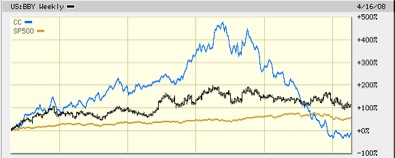Great Selling by Truth Telling: A Best Buy Tale
I was in Best Buy the other day.
The sales guy was excellent. He was open about what he knew and what he didn’t. He advised us to spend more, or to spend less, depending on what we wanted and needed in the several product lines we were exploring. He was candid. He spoke quickly and directly, in short, to-the-point sentences.
When we finished, I asked him, “You’re not on commission here, right?”
“No, not here. I’ve sold on commission before, though.”
“Which do you like better?” I asked.
“Oh, I prefer this. You can tell the truth.”
“You can tell the truth?”
“Yup. The other way, sometimes you’ve got to make the month, or bend it around for some other reason. It’s hard. Here you just tell the truth. It’s a lot easier.”
Just tell the truth–it’s a lot easier.
Let’s parse that: then evaluate it.
Why is it a lot easier?
1. There’s only one version of the truth—an infinity less to remember.
2. It’s easier to answer questions—it requires only short-term memory, not creative license.
3. It’s easier for people to tell you’re not lying.
4. People buy more from you if they feel you’re telling the truth.
5. People tell their friends; truth-telling is good marketing.
Of course, some people feel this is a sucker’s game. It’s sales right? The point isn’t to tell the truth, it’s to not get caught not telling the truth? To look like you’re telling the truth, not to actually tell it.
After all, we’re in business—right?
So let’s have a look at the numbers.

Here is a 5-year stock chart for Best Buy, tracked against the S&P500, and against Best Buy’s most obvious US competitor, Circuit City. (BBY is the one that ends at the top, by the way).
And sure, you can make charts look any way you want. I’m not trying to be an analyst here. I’m just saying the case is not only intuitive, but very plausibly empirical as well.
(By the way, Bear Stearns rated it underperform back in January. Goldman Sachs rates it a Buy. Cheap shot? Maybe, but I’m just sayin’…)
Telling the truth is not stupid, wussy, or bad business. Far from it. It’s very good business. And for pretty obvious reasons.
And that’s the truth.
